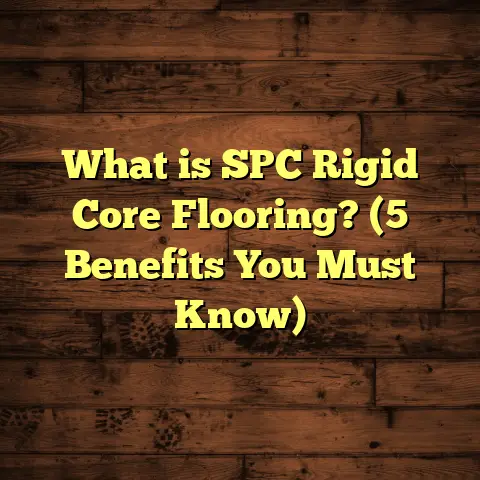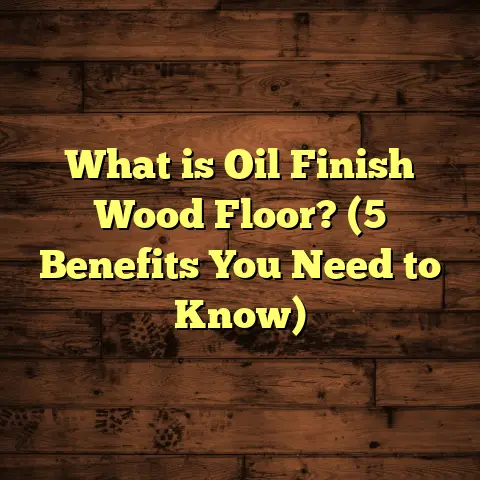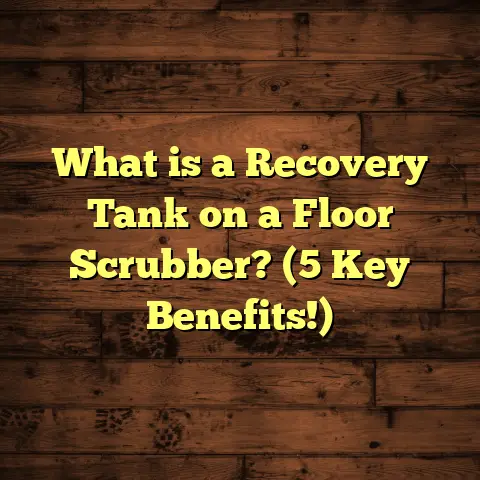What Is Subfloor Beneath Linoleum? (5 Key Insights Revealed!)
Have you ever peeled back a linoleum floor or thought about what’s underneath it? Maybe you’re planning a renovation or just curious about why some floors last longer than others. I remember my first experience with linoleum – I was excited about the colorful patterns and how easy it seemed to install. But soon enough, I found out that what’s beneath the surface matters just as much as what’s on top. If you want your linoleum to look good and last long, understanding the subfloor beneath it is key.
In this article, I’ll share everything I’ve learned from years of flooring work and research to help you get the most out of your linoleum floor. You’ll get practical tips, real stories from job sites, and details about materials and techniques you can apply right away.
What Is the Subfloor Beneath Linoleum?
Let me start by getting straight to the point: the subfloor beneath linoleum is the base layer that supports your linoleum flooring. It’s usually made of wood panels like plywood or OSB (oriented strand board), concrete slabs in some cases, or other materials depending on how your house was built.
Think of it as the foundation of a building but for your floor. The stronger and more stable this foundation is, the better your linoleum will perform. A weak or uneven subfloor can cause all sorts of problems like bumps, cracks, or moisture damage that ruins your floor’s look and durability.
I’ve seen homeowners jump straight to picking linoleum color or pattern without checking what’s underneath. That’s like buying an expensive car and never changing the oil. Eventually, things break down.
Why Should You Care About the Subfloor?
Because it directly affects:
- Floor flatness: An uneven subfloor will show through thin linoleum.
- Durability: Weak subfloors flex and crack, damaging the surface.
- Moisture resistance: Water can seep up through some subfloors and ruin linoleum.
- Noise: Loose subfloors cause squeaks and creaks underfoot.
If you’re like me, you want your floor to look good and feel solid every time you walk on it — not just for a few months but for years.
1. Understanding Subfloor Materials: Which One Is Under Your Linoleum?
Knowing what your subfloor is made of helps you figure out what kind of prep or repairs you might need before installing or fixing linoleum.
Plywood Subfloors
Plywood is made by gluing several thin layers of wood veneer together with their grains running perpendicular. This cross-layering gives plywood excellent strength and resistance to warping.
I personally prefer plywood subfloors for linoleum because:
- They hold nails and screws well.
- They resist bending under weight.
- They don’t swell as much when exposed to moisture as OSB does.
A client in Seattle had plywood subfloors in her kitchen when we installed linoleum. The floor stayed solid even after several spills and steam from cooking—no bubbles or peeling.
Oriented Strand Board (OSB)
OSB is made by compressing large wood strands with adhesives. It looks rougher than plywood and is often cheaper.
While OSB is popular in new construction, I’ve found it can be a bit tricky for linoleum because:
- It absorbs moisture more readily.
- It can swell or warp if not sealed properly.
- It may not be as smooth as plywood unless sanded well.
For instance, at a project in Florida where humidity was high, OSB subfloors caused some bubbling in linoleum after a minor leak because the subfloor absorbed water quickly.
Concrete Subfloors
Basements or slab-on-grade homes often have concrete subfloors. These are very stable but come with moisture challenges.
Concrete doesn’t flex or bend but can transfer moisture upward, damaging linoleum if no barrier is used.
In one basement renovation I did in Chicago, we measured moisture levels in the concrete slab before installing plywood over a vapor barrier followed by linoleum. That step prevented bubbling and mold growth for years.
2. How Flat Should Your Subfloor Be?
Linoleum is relatively thin compared to other flooring materials like carpet or thick vinyl tile. Because of that, it shows imperfections underneath very easily.
Flatness standards recommend that subfloors be within 3/16 inch deviation over every 10 feet. Anything beyond that usually needs fixing.
Here’s what I do before installing:
- Use a long straightedge (4 or 6 feet) to check for gaps under the edge.
- Mark any high spots or dips.
- Sand down high spots.
- Fill in low spots with leveling compound (thin-set or patching compound).
I once rushed a job on a rental property with an old uneven subfloor. The result? The tenant called within three months complaining about cracks and tears in the linoleum. Fixing that meant pulling up and relaying everything—time-consuming and costly.
Real-world numbers
According to flooring professionals’ surveys, 45% of callbacks for linoleum floors are related to uneven subfloors causing premature wear or damage.
3. Moisture: The Silent Enemy Beneath Your Linoleum Floor
Moisture is probably the biggest hidden threat to linoleum floors when it comes from below.
Linoleum itself resists water well on top but doesn’t stand a chance if moisture seeps up through the subfloor from below, especially in basements or kitchens.
What happens if moisture gets under your floor?
- Linoleum can bubble or warp.
- Adhesives lose their grip.
- Mold or mildew can develop.
- Subfloor wood can rot or swell.
I learned this during a bathroom remodel where the old subfloor wasn’t sealed properly over the concrete slab. After a few months, we noticed bubbles forming in the linoleum around the toilet area due to slow leaks and moisture migration from below.
How do you check moisture levels?
You’ll need a moisture meter designed for wood or concrete.
- For wood subfloors, moisture content should be below 12%.
- Concrete slabs should have relative humidity below 75% (measured by specialized tests).
If levels are high:
- Use vapor barriers (plastic sheets) over concrete.
- Apply sealers on wood panels.
- Consider installing a moisture-resistant underlayment designed for linoleum floors.
4. Subfloor Thickness and Support: Don’t Skimp Here
Thin subfloors tend to flex underfoot. That flexing leads to creases and cracks in linoleum over time.
Generally:
- Plywood thickness should be at least 3/4 inch for joist spacing up to 16 inches.
- If joists are spaced wider (say 24 inches), thicker panels or additional support are necessary.
One memorable project was a cabin renovation where flooring was originally installed over half-inch plywood on wide joists (24 inches). The result was a springy floor that caused cracks in the linoleum surface within months.
Reinforcing by adding new plywood sheets on top solved it completely.
5. Fastening Your Subfloor Correctly: Avoid Squeaks and Movement
You might assume nails are good enough to hold down subfloor panels. But screws generally work better because they resist loosening over time.
Here’s my fastening advice:
- Use screws spaced every 6 inches along panel edges.
- Space screws every 8 inches in the middle.
- Make sure panels fit tightly with no gaps.
- Avoid overdriving fasteners which can weaken holding power.
On a recent job, an old floor had panels nailed irregularly with large gaps between fasteners. The homeowner complained about creaking noises when walking on it. Re-screwing all loose panels fixed that instantly.
Additional Tips From My Flooring Experience
Don’t Install Linoleum Over Damaged Subfloors
Rot, mold, water damage — all these weaken your subfloor and need repairing before laying new flooring.
I once found hidden mold under an old kitchen floor after pulling up linoleum during renovation. We had to replace sections of plywood and improve ventilation before new flooring went down.
Use Underlayment Designed for Linoleum
A thin underlayment adds cushioning and smoothness while providing a barrier against minor imperfections or moisture.
Products like foam pads or felt underlayments designed for resilient flooring work well here.
Consider Professional Inspection
If you’re unsure about your subfloor condition, consider hiring a flooring inspector or contractor who can measure moisture levels, flatness, and structural integrity before purchase or installation.
Case Study: Repairing a Subfloor Before Linoleum Installation
A family in Portland called me after their new linoleum started bubbling within weeks. On inspection:
- The subfloor was OSB with swelling due to previous water leaks.
- Moisture content was above 15%.
- Panels were only nailed sporadically and unevenly spaced.
- Subfloor thickness was 1/2 inch on wide joists (24 inches).
We removed damaged panels, installed plywood with proper thickness, used vapor barriers over concrete sections below, screwed down panels every 6 inches along edges, filled low spots with leveling compound, and finally laid the linoleum on top.
Result? A flat, dry floor with no issues after two years of use—proof that investing time in subfloor prep pays off big time.
How to Budget for Subfloor Preparation
Many people forget to include subfloor repairs or upgrades in their flooring budget until problems arise mid-project. Here’s some rough cost guidelines based on my experience:
| Task | Cost Range (USD) |
|---|---|
| Moisture testing | $50 – $150 |
| Minor leveling compound | $100 – $300 per room |
| Replacing plywood panels | $3 – $5 per sq.ft. (materials + labor) |
| Installing vapor barrier | $1 – $3 per sq.ft. |
| Additional fastening (screws) | $0.05 – $0.10 per sq.ft. |
Including these items upfront can save thousands if you avoid callbacks or floor failures later.
Common Questions About Subfloors Under Linoleum
Q: Can I install linoleum directly over concrete?
A: Yes, but only if moisture levels are low and there’s a vapor barrier installed first to prevent moisture from damaging the linoleum adhesive and surface.
Q: What if my subfloor has squeaks?
A: Squeaks usually mean loose panels. Adding screws spaced every 6 inches along edges can tighten things up and reduce noise.
Q: Can I install linoleum over existing flooring?
A: Sometimes yes, but only if the existing floor is flat, dry, and stable enough to support new material. Otherwise, removing old layers is safer.
Wrapping Up: How To Treat Your Subfloor Right for Linoleum Success
If you want your linoleum floor to stay beautiful and functional for years:
- Identify your subfloor type (plywood/OSB/concrete).
- Check flatness with a straightedge; fix if needed.
- Measure moisture levels; install vapor barriers if necessary.
- Confirm thickness meets standards; reinforce if needed.
- Fasten panels tightly with screws to avoid movement.
- Repair any damage like rot or mold before starting.
- Use appropriate underlayment for added protection.
Taking these steps might sound like extra work now but will save you from headaches later on. When I follow these guidelines on every job, clients hardly ever call back with problems — and that feels great!
Got questions about your current floor setup? Just ask—I’m happy to share more tips based on your situation!





